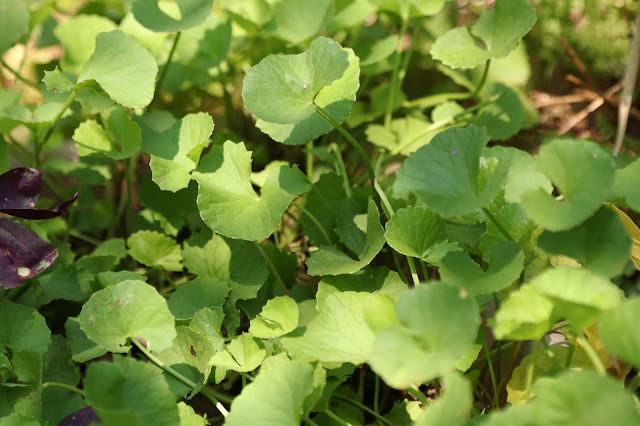Variously known as thankuni, gotu kola, Indian pennywort or Centella Asiatica, this little rounded leaf growing across Asia should be eaten whenever possible. Its list of benefits is so wide that it is sure to have a good effect on you in some way.
Last year when I was in Kolkata, my son Auroni and I went to
Lansdowne Market one morning. There we chanced upon a ‘saag mashi’ or old lady
selling a variety of unusual greens in her basket. They were obviously
handpicked from her fields and tied in little bundles with great care. We
rummaged around for unusual leaves that we weren’t familiar with, and went back
to Auroni’s restaurant kitchen with three new varieties. Most of the kitchen
staff there is from the rural fringes and rooted in Bengali cooking traditions.
They immediately identified the saags or greens and enlightened us urban
ignoramuses. One was thankuni, one was brahmi (used widely as a brain vitaliser
in Ayurveda) and the third was kulekhara, a herb good for increasing one’s
hemoglobin. One of the chefs, Milon, who has an amazing hand in Bengali
cooking, whisked away the thankuni and came back in minutes with a freshly
ground chutney in which he added garlic, coriander, green chilli and raw
mustard oil. This is the way his mother and grandmother made it, he said.
 |
Milon and Auroni in Kolkata |
I
went back home to Kanha treasuring my newfound knowledge and sprang it on
Jhampan who is so into his herbs and plants. But Jhampan sprang a surprise back
at me. He already had thankuni growing in the nursery. Only he knew it by the
Sri Lankan name 'theni'. While visiting Colombo he’d stayed at a guesthouse with
an amazing garden and the owner had enthusiastically given him cuttings of many
medicinal plants all of which were now being nurtured in Salban, Madhya Pradesh!
Further research taught me that the scientific name for
thankuni is Centella Asiatica, in
Tamil it is gotu kola, and in English it is called Indian Pennywort. It belongs
to the Apiaceae family that includes the more familiar carrots, parsley and
celery. Thankuni pata (leaf) as you must have guessed by now, is the Bengali
name. Growing in tropical climates and close to water, this herb is found across
South Asia and Southeast Asia. In each country it is adapted to the local
cuisine, used variously as a chutney, sambal, salad or herbal drink. Each
kitchen has tried to make it tasty, but basically it is eaten for its myriad
medicinal benefits.
 |
The village Bengal chutney ingredients |
Jhampan was served gotu kola in Colombo as a fresh salad
with grated coconut, chilli, lemon juice and salt. But in Sri Lanka it is also made
into a mallum meaning to mix up (just as in Bengal we have the term ‘makha’),
where the leaves are tossed with mustard, curry leaves, garlic, chilli, and
sometimes even dried fish to add punch. The leaf paste is also added to sweet
rice porridge, obviously for its super medicinal properties. In Vietnam, Malaysia
and Thailand it is tossed fresh into a variety of salads. But an emerging
health food trend is to serve it as a green herbal drink, and it is growing in
popularity just as other new age ingredients like roselle and chrysanthemum. At
Salban we generally grind it into a green chutney, adding fresh coriander, a
few mint leaves, lemon juice and green chilli. But Milon’s traditional Bengali way
of pepping it up with raw mustard oil is equally tasty.
 |
We love having thankuni chutney with millet dosas at Salban |
And what are the benefits of this leaf? The range of merits
is so enormous that one is led to believe it is quite the miracle plant. I won’t
dwell widely on this aspect as you can get reams and reams of information on
the net. Thankuni has been widely used in Ayurveda and traditional Chinese
medicine, and its uses are myriad. A paste made of the leaves is used to heal
wounds, reduce scars as well as to treat skin ailments. It is used to boost the
memory, relieve stress, and for depression and insomnia. It’s also good for the
circulation as well to reduce water retention, varicose veins and joint pain. It
has traditionally been used to cure hepatitis, ulcers and gastrointestinal disorders.
Some of the efficacies have been proven through research, while others are
simply accepted through centuries of traditional knowledge. Whatever may be the
case, we have come to the conclusion that it never harms you to chuck a few
gotu kola leaves into your salads, chutneys and sabzis if it is growing or sold somewhere
around where you live. Cheers to this little round leaf with a wavy edge!

Wow...you live and learn...thank you so much for this interesting piece of information about which I didn't have a clue !
ReplyDeleteMy jharkhandi househelper was thrilled when she found these growing wild near our pond at the farm. That was 5 years ago. Since then we have been eating it as saag, as chutney, salad etc. Loved your idea of adding raw mustard oil. Will try that. Lot of people call it Brahmi by mistake, so if you search for brahmi on YouTube you will get tons of recipes.
ReplyDeleteHow interesting. Will start scouting around for this immediately. Thanks for sharing and love the pics. Stay safe. See you on the other side
ReplyDeleteIt’s called Vallarai keerai in tamizh !
ReplyDeleteThanks for sharing such an informative post! This is my first time visiting your blog, and I found a lot of interesting and useful content here. I also write about Nainital and have shared some insights, including the best hotel in Nainital and the best places to visit. If you're interested, feel free to check out my profile and visit the Nainital Lakeview Hotel page for more details.
ReplyDelete